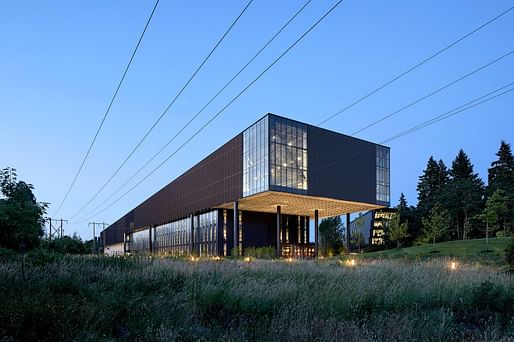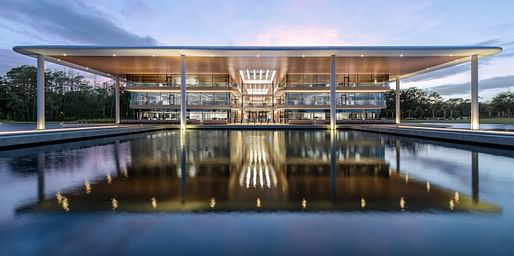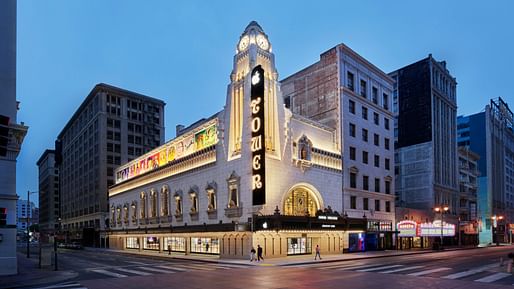
2021 was a year where form continued to follow finance. Throughout the year, our coverage included many examples of the world’s largest architecture firms designing for some of the world’s largest companies. From sleek corporate headquarters to “work-and-play” tech campuses, such projects take on an added significance when searching for clues on the future of work and offices post-pandemic.
However, as we followed the money this year, we also took time to reflect on what lies in its wake. What are the social ramifications of large tech companies landing space-age campuses on areas already creaking from a lack of affordable housing? What does the growing proliferation of Amazon fulfillment centers mean for traditional retail typologies? What are the human consequences of placing the governance of civic space in private hands?
To further explore this point, we have rounded up the highlights of our 2021 coverage on the intersection between architecture and corporatism — for better and for worse.

Olson Kundig designed the LeBron James Innovation Center for Nike
The 750,000-square-foot facility, which opened in October, will be used by the global sports brand as a base for research, prototyping, and testing for both data analysis and products.

Foster + Partners designed a global headquarters for the PGA Tour…
The building brings the entire organization under one roof for the first time. It focuses on health and wellbeing, with a design that blurs the boundaries between the surrounding landscape and the interior spaces.

…and continued its long-running partnership with Apple
This year, the results included the restoration of both the Tower Theater in LA and a 19th-century palazzo in Rome. In the meantime, the Apple Marina Bay Sands in Singapore was honored at the 2021 Prix Versailles.
Pelli Clarke Pelli’s Google Tower continued construction ahead of schedule
Construction of the 35-story office building began in March 2019 and was originally scheduled for completion in August 2022. However, this has been pushed forward to May, and in July, it was reported that the tower had topped out at 590 feet.
Bjarke Ingels Group unveiled an infinity loop headquarters for OPPO…
Named the O-Tower, the scheme seeks to reflect the company’s ethos of “endless innovation in the pursuit of perfection” and serve as an iconic gateway to Hangzhou’s Future Sci-Tech City.
…while also helping The Metals Company reimagine the future of metal production
The resulting suite of BIG’s designs includes seafloor mineral collector robots, carbon-neutral vessels, and waste-free metals processing and recycling plants to enable a circular supply chain.
Google gained approval for its ‘Downtown West’ mega campus in San Jose
The project is the largest single project ever proposed for San Jose and is reported to cost more than $1 billion. The campus will include 4,000 housing units, 1,000 of which are allocated as affordable units in a state that needs 3.5 million housing units for all income levels over the next four years to meet demands.
Apple announced a $1 billion North Carolina campus
While Apple's announcement boasted big numbers for its various expansion goals within the U.S. in general, and in North Carolina specifically, details on planning and design of the new campus in the Research Triangle area have not been revealed yet.
Amazon designed (and then redesigned) its $2.5 billion HQ2 in Virginia
Changes were made to the facades, material, and envelopes of all three buildings, all of which will feature increased biophilic design. Amazon also said it has added an additional 5,500 square feet of planted areas as well as a new east-to-west pathway that will aid in users’ increased wayfinding ability.
Hudson Yards’ Vessel is a sinking ship; when developers fail to listen, tragedy casts a long shadow
When mitigating potential disasters and safety infringements, how long does it take for developers to listen? In the case of The Vessel at Hudson Yards, it took four lives, all under the age of 25.
"The Helix embodies much of the cynicism of both public relations and architecture," writes Wagner. "It is a 'landmark' that is closed off, isolated, and policed — an architectural testament to corporate power."
Amazon’s buying up of dead malls — adaptive reuse, or just eating its prey?
This isn't the first time a multi-billion dollar business has attempted to convert a struggling or unused space into a profit-churning site. However, a growing pattern of concern looms over these "Amazon towns."
A homeless encampment is growing on Apple's future North San Jose campus
Apple bought parts of the 55-acre site in North San Jose in early 2018 and currently holds no publicized plans for its development. Meanwhile, nearly half of the U.S.'s homeless population lives in California alone.
Amazon warehouses are wreaking havoc in California’s Inland Empire
Despite the boiler-plate promise of adding jobs to the community, warehouse-laden tracts have been dumping an increasing amount of pollutants into the atmosphere in the form of increased truck and air cargo traffic and propelled in part by a sharp rise in online shopping.
No Comments
Block this user
Are you sure you want to block this user and hide all related comments throughout the site?
Archinect
This is your first comment on Archinect. Your comment will be visible once approved.